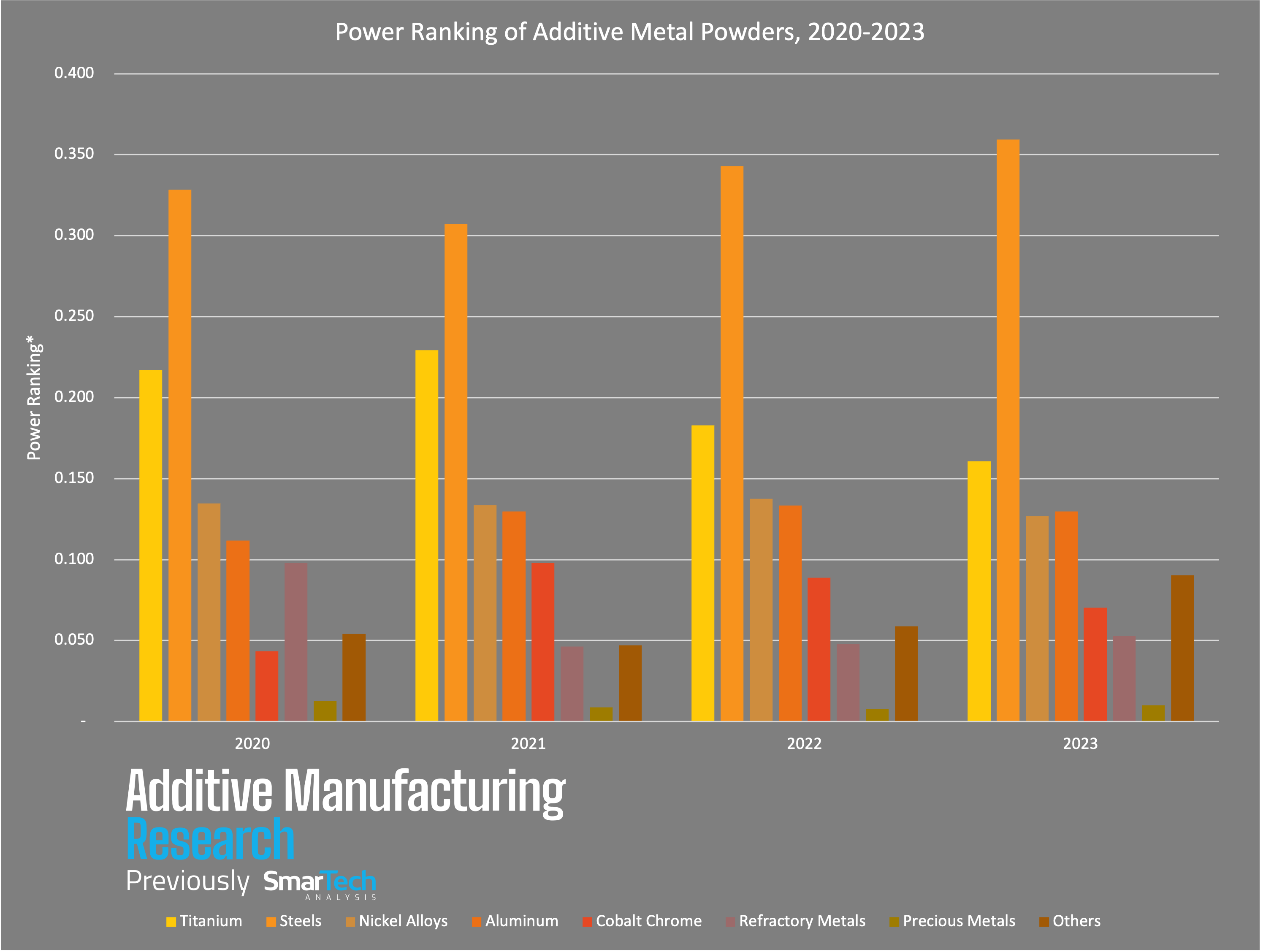The “Chart of the Week” from Additive Manufacturing Research (AMR) is a weekly segment that offers readers a dive into the additive manufacturing (AM) landscape, showcasing pivotal statistics and trends derived from AMR’s exhaustive research. The latest chart provides AMR’s “Power Ranking” of various metal types in metal AM powders.
In tracking the metal powder market, it’s important to balance out such factors as growth and volumes. For instance, materials that ship in smaller volumes annually may have higher growth rates. Additionally, metals have different densities, so tracking the mass of powder shipments doesn’t tell the full story. In the case of aluminum, a ton of powder represents much more volume than a ton of steel.
Thus, in order to properly compare how important a metal is to the overall 3D printing market, AMR has developed the Power Ranking. The total market share of the volume of each metal powder type in a given year has been multiplied by the growth rate (given as a percentage) of that metal’s powder shipments in the same year. This value is multiplied by 100 to give the raw ranking, which is then divided into the total sum of all rank values in a given year to normalize for comparison across years.

Looking at the most recent Power Ranking chart from AMR reveals some interesting trends. Titanium, for instance, shows a prominent position within the ranking. This is indicative of its vital role in AM due to its strength-to-weight ratio and corrosion resistance, making it desirable for aerospace and medical applications. On the other hand, steels demonstrate a consistent presence, underlying their foundational role in various industries due to their versatility and performance.
Nickel alloys also command attention, due to their high-performance characteristics in extreme environments, making them indispensable in sectors such as aerospace and energy. Meanwhile, aluminum’s ranking highlights its growing popularity, owed to its lightness and the push for more fuel-efficient components in the automotive and aerospace sectors.
Other categories, like cobalt chrome, refractory metals, precious metals, and others, though smaller in volume, show varying degrees of growth and market share, reflecting niche applications or emerging trends in the AM landscape.
The chart not only serves as a snapshot of the current state but also as a predictive tool for future trends. For instance, metals with high growth rates but smaller volumes might indicate emerging materials that could disrupt the market if their application scope widens.
Subscribe to Our Email Newsletter
Stay up-to-date on all the latest news from the 3D printing industry and receive information and offers from third party vendors.
You May Also Like
Gorilla Sports GE’s First 3D Printed Titanium Cast
How do you help a gorilla with a broken arm? Sounds like the start of a bad joke a zookeeper might tell, but it’s an actual dilemma recently faced by...
Nylon 3D Printed Parts Made More Functional with Coatings & Colors
Parts 3D printed from polyamide (PA, Nylon) 12 using powder bed fusion (PBF) are a mainstay in the additive manufacturing (AM) industry. While post-finishing processes have improved the porosity of...
$25M to Back Sintavia’s Largest Expansion of Metal 3D Printing Capacity Since 2019
Sintavia, the digital manufacturing company specializing in mission-critical parts for strategic sectors, announced a $25 million investment to increase its production capacity, the largest expansion to its operations since 2019....
Velo3D Initiates Public Offering in a Bid to Strengthen Financial Foundations and Drive Future Growth
Velo3D (NYSE: VLD) has been among a number of publicly traded 3D printing firms that have attempted to weather the current macroeconomic climate. After posting a challenging financial report for 2023,...































